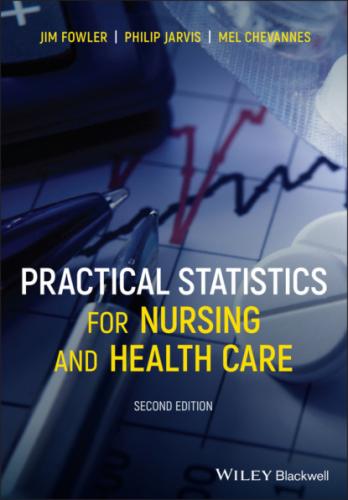Practical Statistics for Nursing and Health Care. Jim Fowler
Advice on Using Regression Analysis
20 15 Comparing Averages 15.1 Introduction 15.2 Matched and Unmatched Observations 15.3 The Mann–Whitney U‐Test for Unmatched Samples 15.4 Advice on Using the Mann–Whitney U‐Test 15.5 More than Two Samples – The Kruskal–Wallis Test 15.6 Advice on Using the Kruskal–Wallis Test 15.7 The Wilcoxon Test for Matched Pairs 15.8 Advice on Using the Wilcoxon Test for Matched Pairs 15.9 Comparing Means – Parametric Tests 15.10 The z‐Test for Comparing the Means of Two Large Samples 15.11 The t‐Test for Comparing the Means of Two Small Samples 15.12 The t‐Test for Matched Pairs 15.13 Advice on Comparing Means
21 16 Analysis of Variance – ANOVA 16.1 Why Do We Need ANOVA? 16.2 How ANOVA Works 16.3 Procedure for Computing ANOVA 16.4 The Tukey Test 16.5 Further Applications of ANOVA 16.6 Advice on Using ANOVA
22 Appendix A: Table of Random Numbers
24 Appendix C: χ2‐Distribution
25 Appendix D: Critical Values of Spearman's Rank Correlation Coefficient
26 Appendix E: Critical Values of the Product Moment Correlation Coefficient
27 Appendix F: Mann–Whitney U ‐test Values (Two‐Tailed Test) P = 0.05
28 Appendix G: Critical Values of T in the Wilcoxon Test for Matched Pairs
32 Appendix K: Leicestershire ECT Study Data: Subgroup with Depressive Illness
33 Appendix L: How Large Should Our Samples Be? L.1 Introduction L.2 Proportions L.3 Calculating Sample Size for a Quantitative Measure
34 Bibliography
35 Index
List of Tables
1 Chapter 3Table 3.1 Weights of 100 babies (kg).Table 3.2 Grouped new‐born baby weights.Table 3.3 Systolic blood pressure of 50 males after myocardial infarct.Table 3.4 A grouped frequency table.
2 Chapter 4Table 4.1 Boys weight‐for‐age percentiles from birth to 24 months.Table 4.2 Gender differences in locations of accidents (percentages in bracke...
3 Chapter 5Table 5.1 Features of clinical trial designs.Table 5.2 Two treatments, two treatment periods (2 × 2) cross‐over design.Table 5.3 1981/2 Leicestershire electroconvulsive therapy study.
4 Chapter 6Table 6.1 Relationship between breast cancer and oral contraceptive usage.Table 6.2 Mortality from coronary disease among smokers and non‐smokers.Table 6.3 Advantages and disadvantages of cohort and case‐control studies.Table 6.4 Choice of comparison group for cohort and case‐control studies.
5 Chapter 8Table 8.1 Calculating a standard deviation from grouped data.
6 Chapter 10Table 10.1 Weights of 100 babies (kg).
7 Chapter 11Table 11.1 Distinctions between non‐parametric and parametric tests.
8 Chapter 12Table 12.1 Frequency of patient deaths.Table 12.2 Head injuries and helmets.Table 12.3 Numbers of women smokers and non‐smokers.Table 12.4 Calculation of expected frequencies.Table 12.5 Depression and suicidal intent (expected frequencies in brackets).Table 12.6 Gender differences in locations of accidents (expected frequencies...
9 Chapter 13Table 13.1 The strength of a correlation.Table 13.2 Chest circumference and birth weight of 10 babies.Table 13.3 Attendance at births by trained care workers in different countrie...
10 Chapter 15Table 15.1 Waiting times (min) at four outpatient clinics (rank score in brac...Table 15.2 Time taken by 15 student subjects (A–O) to undertake a task before...Table 15.3 Ranking of matched pairs.Table 15.4 Growth weights (kg) of matched pairs of babies.
11 Chapter 16Table 16.1 Systolic blood pressure measurements from four hospital wards.Table 16.2 Mean (with S.E.) systolic blood pressure measurements (mmHg) of sa...
12 Appendix LTable L.1 Values of Q to be used in the formula for calculating the required ...
List of Illustrations
1 Chapter 3Figure 3.1 The limits of an observation.
2 Chapter 4Figure 4.1 Dot plots showing frequency distribution of (a) 17 new‐born baby ...Figure 4.2 Bar graph showing distribution of blood‐group types.Figure 4.3 Frequency distribution of traffic accident fatalities.Figure 4.4 Frequency distribution of systolic blood pressure observations fr...Figure 4.5 Frequency polygon of systolic blood pressure observations from 15...Figure 4.6 Frequency curve of 100 new‐born baby weights.Figure
